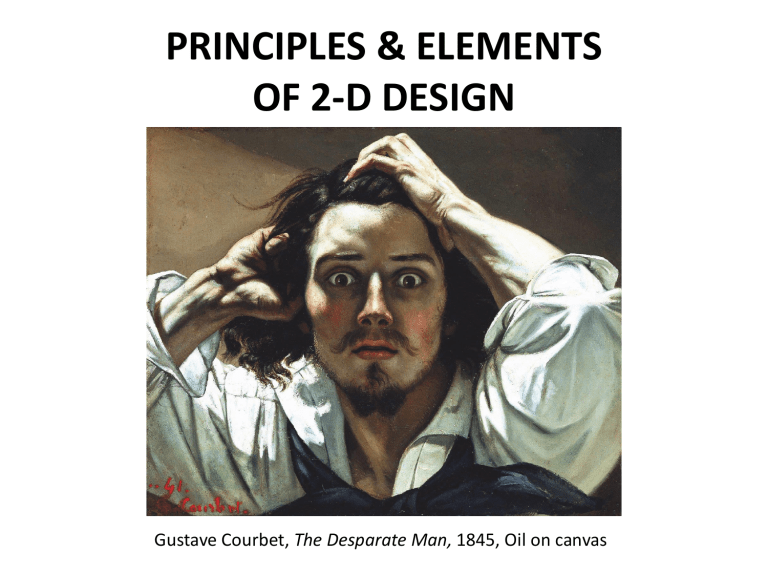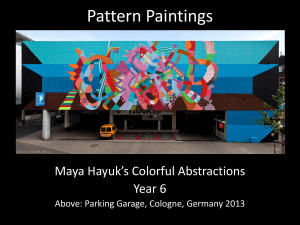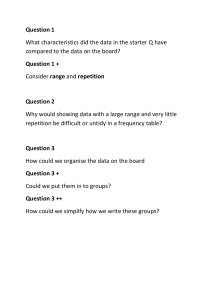
PRINCIPLES & ELEMENTS OF 2-D DESIGN Gustave Courbet, The Desparate Man, 1845, Oil on canvas Composition • The way that lines, shapes and other visual elements are arranged; • Refers to the organization, arrangement, and combination of shapes on a flat surface (picture plane, space) Henri Matisse Elizabeth Murray Visual elements: Line, shape, color, value, texture Identify the elements of art used to compose the artworks above. Also, check some additional helpful information in the notes section underneath the slide. Principles: Unity, variety, balance, movement and rhythm, proportion, scale, emphasis, economy Bridget Riley Susan Hauptman Identify the principle used to compose the artworks above. Also, check some additional helpful information in the notes section underneath the slide. 1. Unity and Variety Unity: The quality of relating the visual elements to create compositional cohesion or oneness. Variety: Differences achieved by opposing, contrasting, or varying the elements in a composition to add interest. (Variety is the counterweight of harmony.) Mark Riedy, Day at the Beach, 1988, Acrylic airbrush Marcos Chin, Falling Off the Workout Wagon How unity/harmony is achieved in above images? Identify elements that differ. How they affect the compositions? Gestalt visual information is understood holistically before it is understood separately Hieronymous Bosch, Garden of Earthly Delights, ca. 1500, Oil on Panel What gestalt principles are at use in this richly composed artwork? Gestalt Principles • Grouping • Containment • Repetition • Proximity • Continuity • Closure Edgar Degas Which Gestalt principles are at work in this image? Martin Handford, Where’s Waldo Repetition, repetition, repetition, … Vija Celmins, Untitled (Ocean), 1970, Graphite Patterns and Grids Bridget Riley, Fragments, 1965, Screenprint Piet Mondrian, Composition II in Red, Blue, and Yellow, 1930, Oil on Canvas 2. Balance KWEST, Toronto, 2016 Balance: A stable arrangement of subjects within a composition; an equilibrium of weight or force among visual components in a composition. How is this image balanced? April Gornik How is this image balanced? Sally Mann How is this image balanced? Weight/Gravity Visual weight of compositional elements has a particular affect on balance in a work of art. Shapes that “weigh visually more” help create hierarchy in terms of space occupied and position in relation to compositional frame and other elements within the image. Ansel Adams, El Capitan, Undated, photo Symmetry Richard Estes, Shinjuku, 1989, Oil on canvas Asymmetrical Balance Edward Hopper “Nighthawks” 3. Proportion Andrew Wyeth, Christina’s World, 1948, Tempera The comparative relationship between the parts of a design to the whole in terms of size. How is the principle of proportion applied in this artwork? Richard Diebenkorn, Ocean Park No. 86, 1975 4. Scale Alex “Hense” Brewer A size relationship between two separate objects relative to a constant standard of measure. (Often related to human dimensions.) 5. Rhythm A visual flow or sense of movement in a design that is created by repetition of multiple units in a deliberate pattern. (Relates to Movement : The use of deliberate visual pathways to help direct the viewer’s attention to areas of particular interest.) Marcel Duchamp, Nude Descending a Staircase, No. 2, 1912, Oil on Canvas 6. Emphasis Emphasis (Also known as Dominance) The principle in which certain elements assume more importance than others in the same composition or design. Elmer Bishoff, Orange Sweater, 1955 Raphael, Transfiguration, 1520, Tempera 6. Economy Apple, Ipod, mid 2000s, advertisement Kathe Kollowitz, Self portrait, 1935, Charcoal The distillation of the image to the basic essentials for clarity of presentation. (Using only what is needed to create an intended affect.) Robert Longo Kerry James Marshall, De Style, Acrylic and Collage on canvas After learning all about the elements and principles of design and seeing their application, try now to analyze the artwork above. Use all the knowledge you acquired from the readings and this presentation.





